Did you know that 28% of what Americans throw into the landfill is food and yard scraps? And that those scraps do NOT break down in landfills? Instead, they emit methane gas which contributes to climate change. But there is good news, too! These food and yard scraps are the very resources needed to heal our precious soils and build organic gardens. And it all starts with home composting.
Compost is the “secret sauce” of a thriving vegetable and herb garden. It is the ingredient that makes a garden healthy and organic!
Here are just a few of the powerful effects of compost:
- Adds LIFE to soil, so you grow even more nutrient-rich food
- Improves water retention so you can save time and money on irrigation
- Suppresses diseases, so your plants are healthy and easier to maintain
- Buffers the pH of your soil to make it perfect for growing vegetables and herbs
So, when you compost, you are building a more resilient future for your local food system. And you have almost everything you need to get started composting right at home.
But before you just start dumping food in the yard and stinking up the neighborhood, there are five secrets to creating easy home compost without any stinky odors.
Secret #1 – Choosing a Home Composting Style that’s Right for You
Now that you’re ready to get started, you’ll want a process that fits into your lifestyle and takes advantage of the resources you have. This is the #1 secret to easy compost. It may sound weird, but home composting is a bit like brushing your teeth — it’s a habit that you build every day.
Keep in mind — you don’t necessarily have to do your own composting… you may want to find a community garden or municipal center that accepts your food and yard scraps. Freezing food scraps keeps them from getting stinky, and then you can simply deliver them weekly to the location of your choice. And if you’re in one of a few select cities, you might even be able to leave compost out with trash and recycling for curbside pickup.
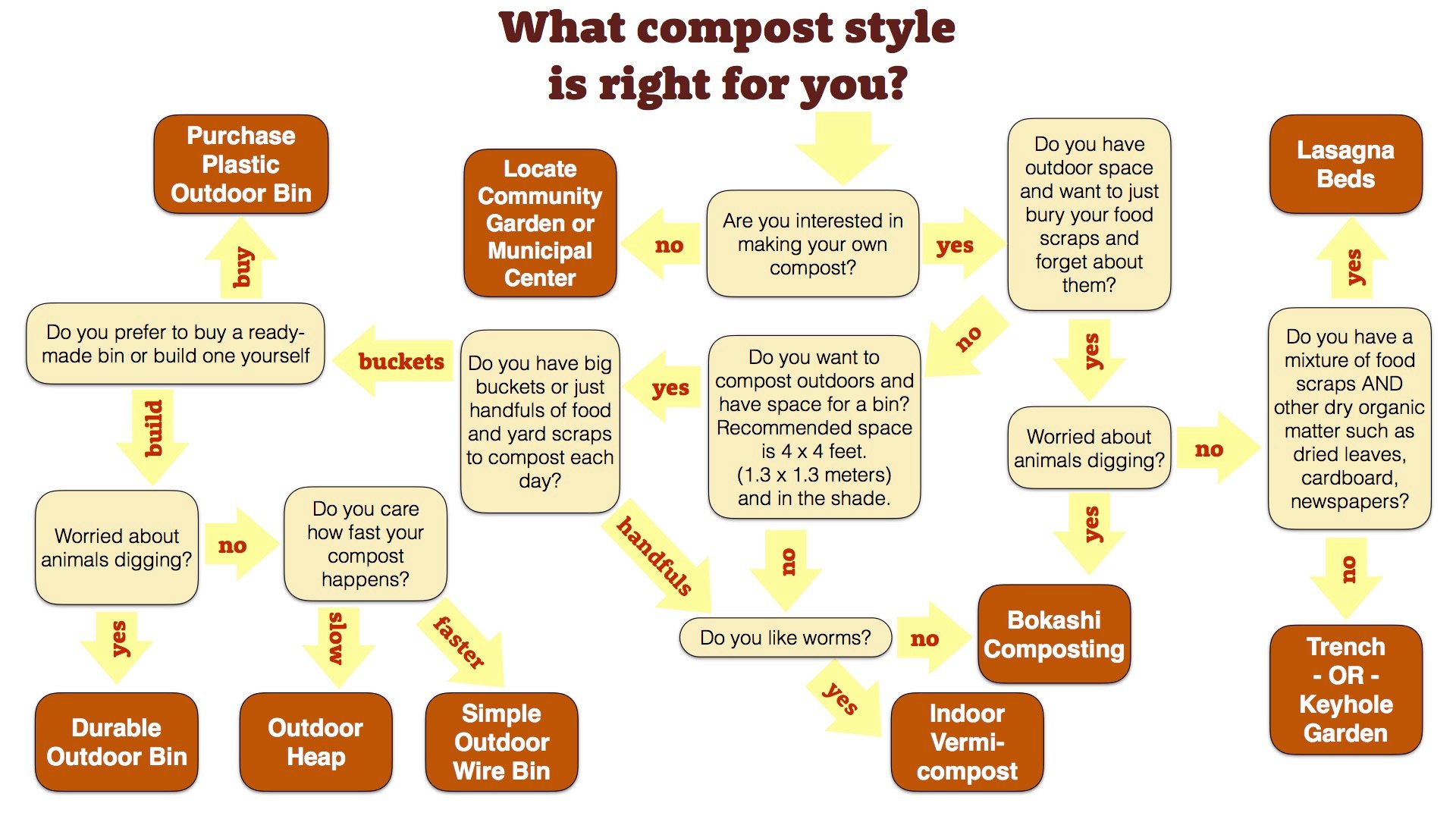
At this point, please resist the urge to skip ahead. Before you ask “which compost bin should I buy?” it’s important to understand how compost happens so that you can build (or buy) a bin that actually works!
For home composting, most people choose aerobic (oxygen-dependent) compost because it is easy to master, which is exactly what this article will help you do. Yard and food waste can break down anaerobically too, but this can be a smellier process and not what we’re going to focus on in this article.
Secret #2 – Relax and Let Nature Do the Real Composting Work
What’s the best part about home composting? It’s a natural process… and it happens all day, every day. There’s no such thing as “waste” in nature. Nature takes everything that is no longer alive and uses it to feed what is and will be alive in the future.
So when you decide to compost… follow nature’s lead. You are merely here to create the best possible conditions for the process to unfold. Do not fight nature, or you will get a gooey, stinky mess.
When you really master this secret, you surrender to the power of nature. And you may become curious about the science of composting. You’ll also get rewarded because the more you know, the less you have to do.
That’s what Secret #3 is all about… discovering the superheroes of the composting process and what they need to do their job.
Secret #3 – The “League of Underground Superheroes,” and the Science of Compost
You may think you’re building a compost pile, but you’re not. You’re creating a home for BILLIONS of microorganisms and insects, too. These are the little guys that are actually doing all the work for you.
I call them the League of Underground Superheroes, who transform trash into treasure for the next generation. Their superpower is recycling EVERYTHING organic. They are bacteria, fungi, and actinomycetes (microbial decomposers), and there are more of them in a handful of compost than there are people on the planet!
So you want to create the ideal habitat for these little critters and make them feel right at home — like you would for any pet. To welcome them, give them three basic essentials: air, water, and food. They will take care of everything else.
Air
All of these microorganisms are aerobic meaning they need air to function. The good news is that there will be lots of air in your compost if you create the perfect recipe (see Secret #4).
Water
All of life needs water to thrive, and microorganisms are no different. You want about 40% moisture in compost so that they have access to water but don’t drown. Secret #4 will give you the recipe to create the perfect moisture content you need.
Here’s an easy way to test the moisture level of your compost:
Grab a handful of compost and squeeze it into a ball. If it sticks together without leaking water, then it is the perfect consistency. If it does NOT stick together, it is too dry. If water squeezes out, it is too wet. (Tip: Wash your hands with soap after handling compost — or use a glove.)
Food
You have to provide a never-ending buffet of food and yard scraps for the League of Underground Superheroes so that they never need to leave to find their next meal. But it’s important to separate those scraps into three categories before you start composting.
What NOT to Put in Your Compost Bin
This is THE MOST important category to understand. Yes, everything DOES break down over time, and people with more experience can compost anything organic. But if you’re just getting started and want to make your compost as simple and earthy-smelling as possible… there are some things you’ll want to avoid: meat, dairy, fish, grease, and anything larger than your fist that can’t break down into smaller pieces.
Greens
Sometimes referred to as ‘wet’ scraps, consider these materials as “recently deceased.” They still have a lot of moisture present and typically have a higher content of nitrogen too.
Browns
Sometimes referred to as ‘dry’ scraps, these materials are dried out. You could easily burn them because they’ve been dead for some time. Most of their nitrogen has been used up, and now, they are rich in carbon. Many people use dried leaves that they collect in the fall. Other options are dry straw, sawdust, or even shredded paper.
Once you’ve identified your “greens” and “browns” for your compost, you’re ready to create the perfect blend. And yes, you do need BOTH.
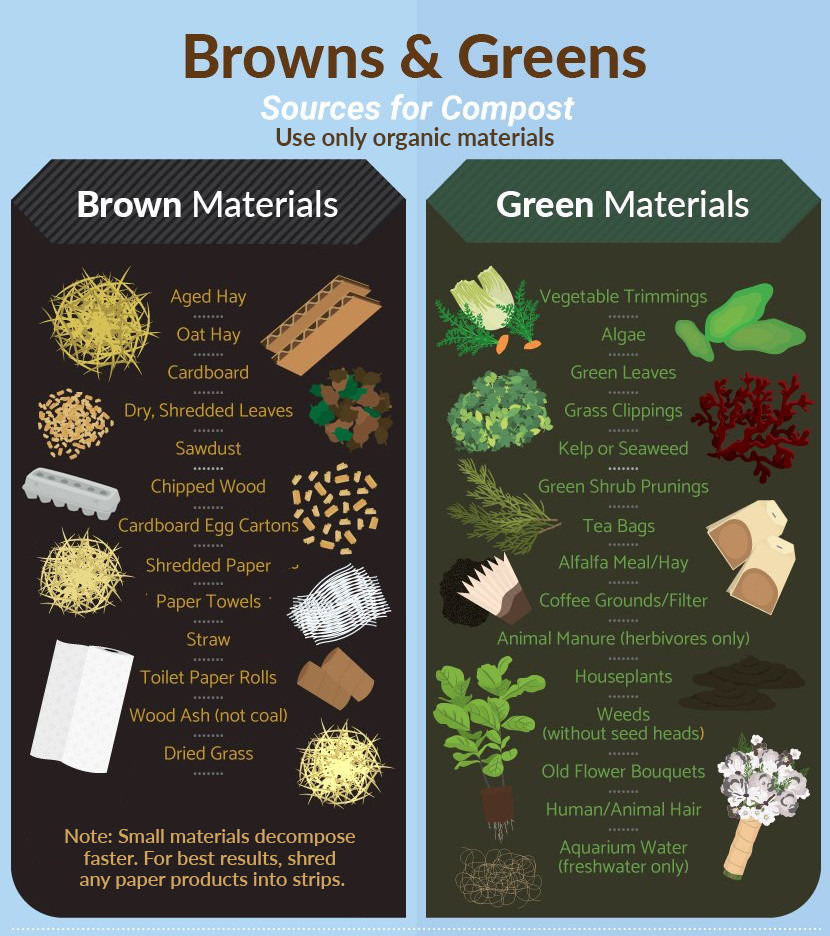
Here’s an Important note on ORGANICS before you get started:
One reason you may be growing your own food is to avoid any toxic chemicals of industrial agriculture. To keep your garden clean, confirm any materials you compost are safe and/or organic. This will give you peace of mind that your precious harvest is toxin-free, too.
When choosing what to compost, trace materials back to their source. For example, ask how hay or straw was grown, because herbicides may have been sprayed in the field. Ensure that animal manures are from animals who graze on organic fields (not from factory farms).
For EVERYTHING on the list, ask where it came from and decide if you are okay with the answer. If in doubt, leave it out. Choose something you feel good about.
Secret #4 – The “Layered Cake” Recipe for Successful Composting
Now that you know what to feed the League of Underground Superheroes, how do you combine the perfect recipe so that they can feast to their heart’s content and give you perfect compost every time?
You’ll see people recommend all kinds of compost recipes. But they are all variations of the same, simple “layered cake” recipe.
For a moment, consider successfully baking a cake (a REAL cake)… The critical part is getting the ratio of wet to dry ingredients just right. And composting is the same way.
Create a “layered cake” by piling up your brown and green materials in alternate layers. Most composting facilities and farmers achieve the best results with a 2:1 brown to green ratio.
Want to geek out on the science for a moment? Technically, the ideal ratio of CARBON to NITROGEN for the most successful compost is 25:1. But because all organic materials constantly change percentages of nitrogen and carbon as they transition from “recently deceased” to “completely dried out,” you would drive yourself crazy trying to calculate this.
Not all greens are 100% nitrogen, and not all browns are 100% carbon. So luckily, you don’t actually need to find 25 times more browns than greens.
Now, as you build your compost “layered cake,” there’s one important thing to know about these layers. Each green layer should never be more than 6” (15cm) deep. Any deeper than that and the ideal surface contact between layers is gone, and your League of Underground Superheroes may not do their job properly.
Making Adjustments for Perfect Compost
Finally, while 2:1 is the ratio most people use for the best results, sometimes you have to make an adjustment as the pile starts to decompose.
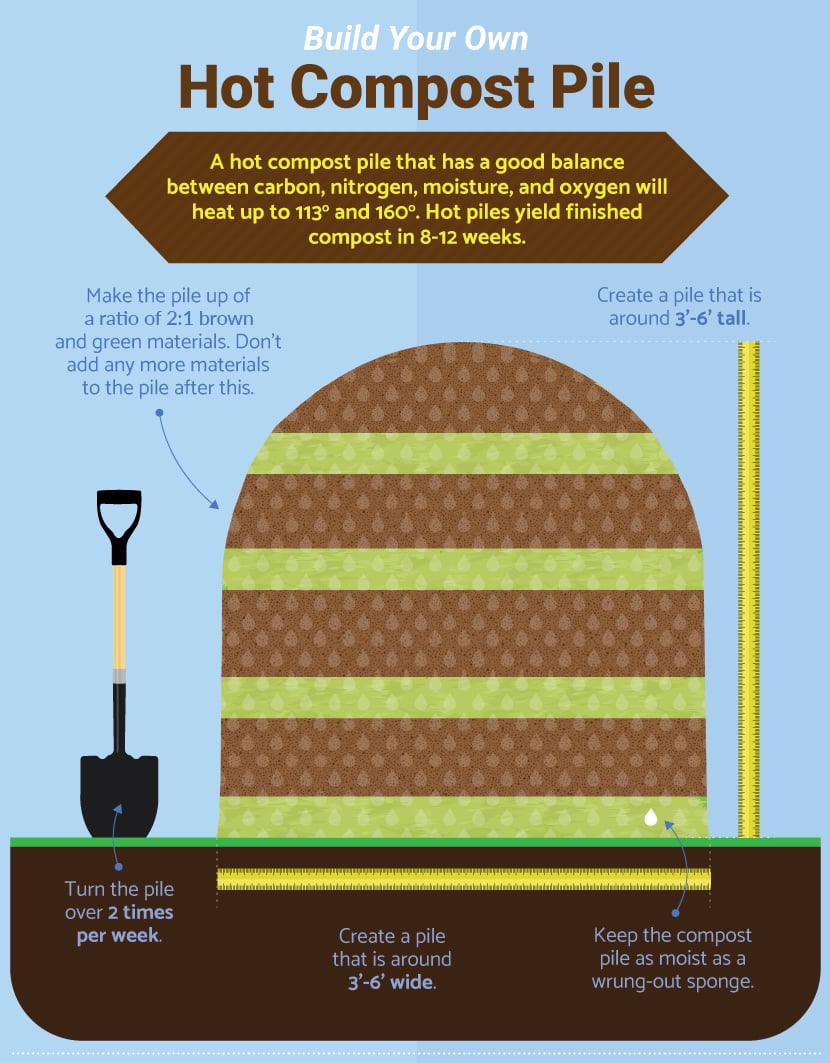
When your compost pile smells nice and earthy, you have just the right amount of air, moisture, and browns to greens ratio. However, if you find your pile is stinky or too wet (remember the hand squeeze test), you’ll need to layer in more browns. And if you find your compost is too dry or it’s not composting at all, add a little more green to the layering process.
When you get your compost recipe just right, your microorganisms will emit so much energy that they’ll increase the temperature of your compost significantly. Your compost pile could emit heat as high as 160º F (71º C)! Think of it like a giant party where everyone steams up the windows. And all that heat speeds up the composting process, which is exactly what nature wants.
If you want the fastest compost possible, turn and fluff the pile every week. This will give you workable compost in one to three months.
But if you do nothing at all, it will still compost. It just might take six months to one year to fully decompose.
You’ll know when your compost is done when all the scraps are no longer recognizable. Instead, you have a pile of rich, dark brown, earthy-smelling, crumbly substance that looks a lot like the ground below the leaves of the forest floor.
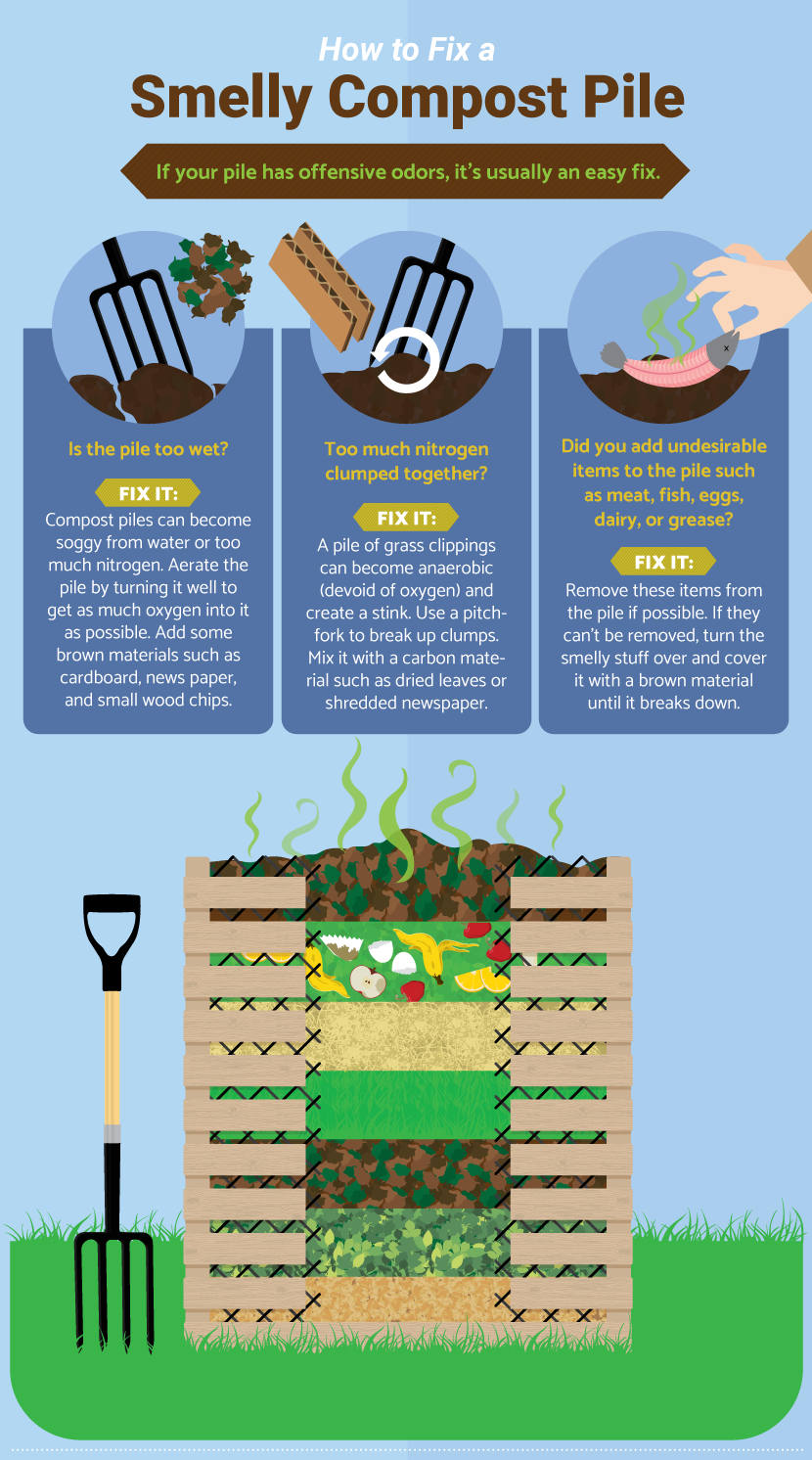
Secret #5 – Building or Buying Your Compost Bin
Now that you know how compost actually works and what the League of Underground Superheroes need to thrive, you are ready to purchase a bin or build one yourself. While there are lots of options, there are essentially three types:
Just Pile It Up on the Ground!
You’ve already read that compost is a natural process. You don’t HAVE TO build anything to hold it all together. However, if you have animals, they may dig through your pile if it’s not contained. A simple wire cage keeps things tidier and may speed up the composting process as well. Covering the top of your pile with a tarp is recommended during rainy times too. Rainwater and condensation can ruin the perfect combination of wet and dry ingredients you’ve already created. Ideally, you want the sides of your pile still open to the air, though.
Build Your Own Compost Bin with Wood, Stakes, and/or Hardware Cloth
Make sure the sides of the bin allow plenty of airflow. Remember, the League of Underground Superheroes, who are doing all the work, need oxygen! A lid is helpful, as it keeps animals out, in addition to excessive moisture from rain and condensation.
Buy a Tumbler
People like tumblers because it eliminates the work of turning the compost. For best results, you want a tumbler that has at least two compartments or else you will always be adding compost to the same compartment, and it will never decompose fully. Look for high quality, durable materials, and reviews that the product is easy to use. If it’s a pain in the butt to put materials in and take them out, you may find it difficult to keep composting. Make sure it isn’t too hard for you to access. Here is the most highly rated dual-chamber tumbler on Amazon.
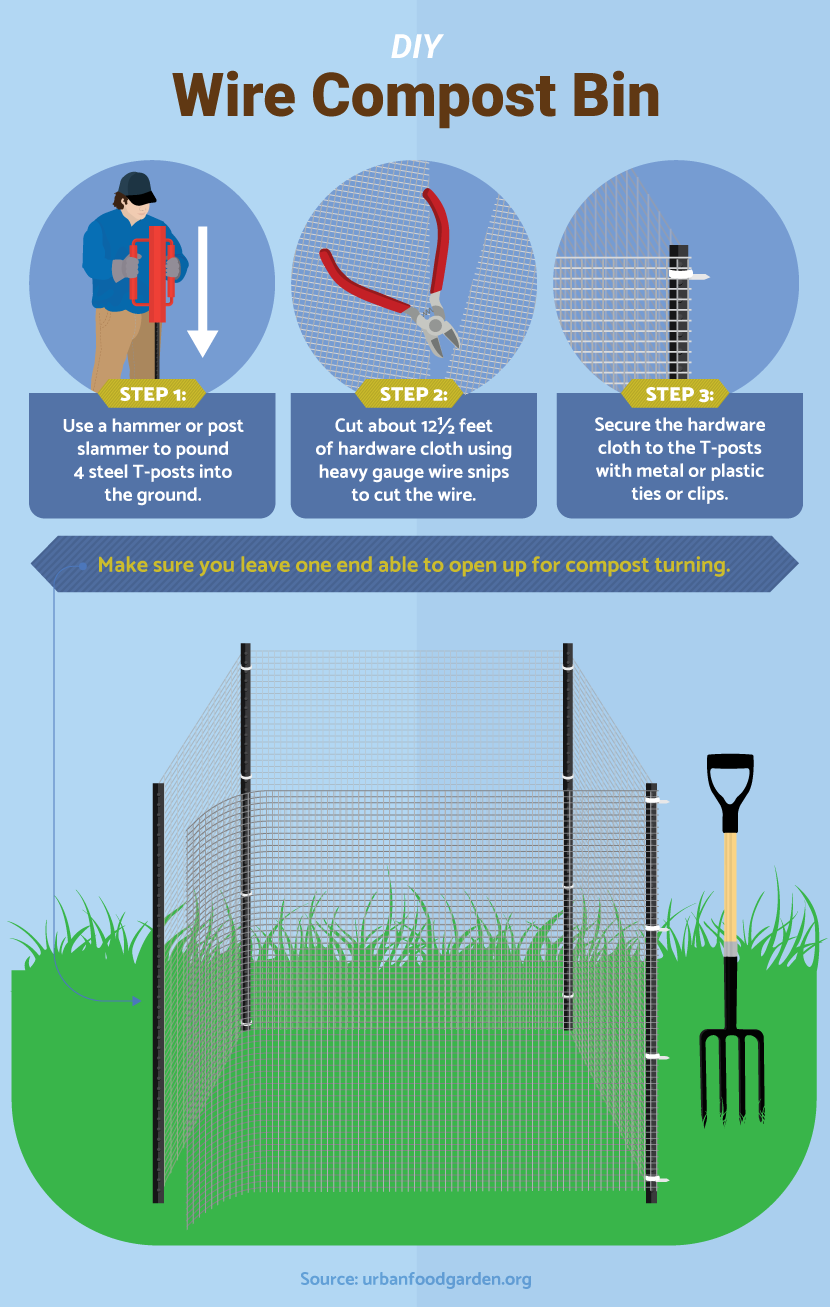
A Great Home Composting Resource
Ready to take your home composting to the next level? Grab my handy action guide: “5 Composting Mistakes and How to Avoid Them: Transforming Trash to Treasure.” This e-guide helps you troubleshoot the process, so you get perfect compost to feed a thriving, organic garden.
Tell us in the comments:
- Have you tried home composting? Why or why not?
- What have been your biggest composting successes or challenges?
Featured Image: iStock.com/CasarsaGuru


